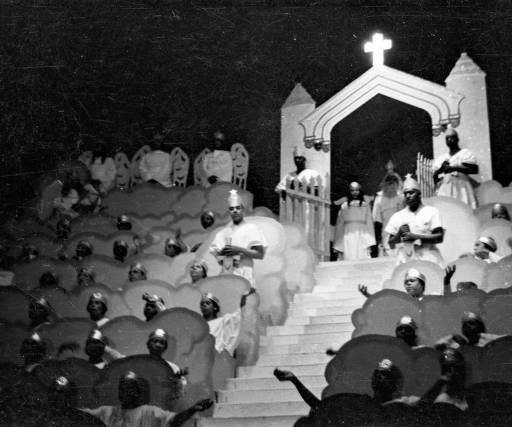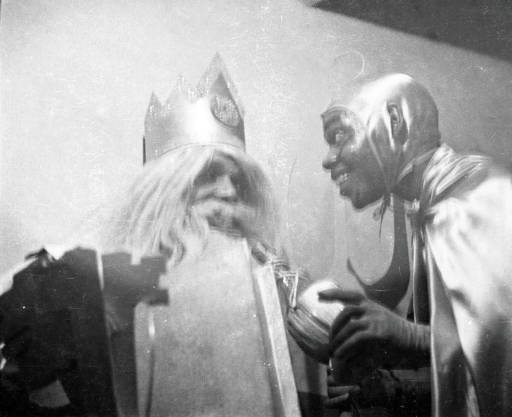Rediscovering “Heaven Bound”
How exciting to discover a box filled with over 90 rolls of film that have been unseen since the 1930s! These previously unknown 35mm negatives offer a remarkable glimpse of life in Atlanta 75 years ago.

Since its acquisition in 1985, the Lane Brothers Commercial Photographers Photographic Collection has continuously yielded up treasures, and these photographic series from the 1930s are among the most extraordinary rediscoveries. Fray DeVore, a junior in the GSU Graphic Design B.F.A. program, has worked steadily on digitizing the film, adding around 50 of the photographic projects to the University’s “Digital Collections” website.

One of the most intriguing projects is the 1937 capture of the Big Bethel’s “Heaven Bound” pageant. A total of 32 images contribute to our understanding of this African American morality play that has been continually performed by the choir of the Big Bethel African Methodist Episcopal Church on Auburn Avenue since it first “informal” rehearsal in November 1929 and its first “official” performance on February 17, 1930. “Heaven Bound” has been variously described as “an African American folk drama”; “the first great American folk drama”; “one of Atlanta’s most enduring traditions”; and “part pageant, part revival meeting, part spiritual charades.” The pageant was conceived by Lula Byrd Jones and co-written with Nellie Lindley Davis. A narrator describes the pantomime actions and the choir weaves together traditional Negro spirituals and hymns, as the pilgrim actors encounter the temptations of the devil on their way to entering the kingdom of heaven watched over by St. Peter.
The Lane Brothers photographed the August 10, 1937 performance of “Heaven Bound” at the Atlanta Theatre at 32 Exchange Place. The performances for 1937 and into 1938 were sponsored by the Federal Theatre Project as part of the Great Depression-era Works Progress Administration. The Federal Theatre Project funds were channeled to the Big Bethel pageant through the Atlanta Theatre Guild, an organization of wealthy white Atlantans. Ironically, only whites could sit in the seats on the main floor of the segregated theater; African Americans were constrained to the balcony. In any case, the theater was always full. Completing its run at the Atlanta Theatre, “Heaven Bound” returned to the Big Bethel Church building where it continues to fill all the available seats to a well-integrated audience.

BIBLIOGRAPHY
The pageant is documented in Gregory D. Coleman’s We’re Heaven Bound! Portrait of a Black Sacred Drama (Athens, Ga.: University of Georgia Press, 1994).
A brief history of “Heaven Bound” can be found in The New Georgia Encyclopedia.
“Religion: Heaven Bound,” an article in Time Magazine (August 10, 1931), is often quoted.
Winona L. Fletcher, “Witnessing a ‘Miracle’: Sixty Years of Heaven Bound at Big Bethel in Atlanta,” in Black American Literature Forum
Vol. 25, No. 1, The Black Church and the Black Theatre (Spring, 1991), pp. 83-92.
William H. Wiggins, Jr., “Pilgrims, Crosses, and Faith: The Folk Dimensions of Heaven Bound,” in Black American Literature Forum
Vol. 25, No. 1, The Black Church and the Black Theatre (Spring, 1991), pp. 93-100.
Hugh T. Keenan, “Heaven Bound at the Crossroads: A Sketch of a Religious Pageant,” in Journal of American Culture 11 (Fall 1988), pp. 39-45.
Redding S. Suggs, Jr., “Heaven Bound,” in Southern Folklore Quarterly 27 (December 1963), pp. 249-266.